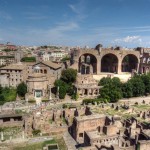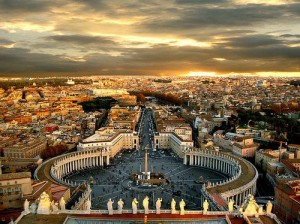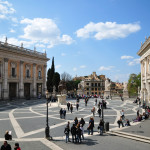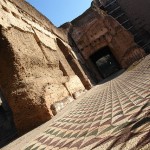
The Colosseum is originally named Flavian Amphitheatre (Colosseo or Anfiteatro Flavio in Italian). This historical building is regarded as the most famous tourism site in Rome and has been the icon of Rome beside the Vatican City. Apart from its popularity, the Colosseum is also considered as the greatest work of Roman architecture and Roman engineering. Although some of its parts have fallen into ruins, we can still see how it was when it still stood together as a whole. Moreover, the ruins of Colosseum still presents us a beautiful sight to see and brings back the ancient Roman atmosphere to the modern Rome.
History of Colosseum
People today simply refer to this one of wonders of the world as Colosseum. However, it was not the name given to it when it was built back in the Flavian dynasty. Flavian Amphitheatre is the original name, referring to the dynasty when it was built in, and it actually still frequently used today.
So where does “Colosseum” come from? It is believed that the name came from a colossal statue of Nero which was once stood nearby the amphitheatre. However, at that time the term “colossus” was used to refer the statue, not the amphitheatre which was still referred as Flavian Amphitheatre. People started to use “colosseum” for the amphitheatre in the 10th century after the statue was torn down.

Colosseum has been standing in the middle of Rome for almost two millenniums. Built around 70 to 72 AD, the Colosseum was built under the Emperor Vespasian on a flat area between the Caelian, Esquiline, and Palatine Hills. The construction was then completed in 80 AD, just one year after Vespasian’s death. It was Titus, Vespasian’s son, who inaugurated the Colosseum later.
Previously in 64 AD, the densely-inhabited area was devastated by the Great Fire of Rome when Nero took over the control of it. It was the time after the seizure of the area by Nero the bronze colossal statue of Nero was built.
The Colosseum was a magnificent architecture achievement and special even in its era. It is believed that the Colosseum was the largest building in its era, not to mention that Colosseum was also located in the center of a city. Most of amphitheatres were back then located in the outskirts of a city.
In 217, the Colosseum was damaged by a big fire which was claimed to be originated from a lightning. A renovation was done in 240, 250, and 320 AD. More natural disasters, this time were earthquakes, hit the Colosseum in 443, 484, and 508. However, those earthquakes seemed not to damage the Colosseum much since contests and animal hunt activities were still held there until the 6th century. The last record of gladiatorial fights, however, was found in 435.
During the medieval period, the Colosseum went through some radical changes. A small church was built and the area was turned into something resembled cemetery. Records also show that some parts of the Colosseum were converted into housing and workshops or rented out for other purposes. After some uncertainty, Frangipani family finally bought the Colosseum in 1200 and turned it into a castle.
In 1349, a great earthquake hit and caused a severe damage to the Colosseum. The southern side of the construction collapsed. The ruined stones were then used to build many other buildings like churches, palaces, and hospitals. The northern side which survived was then inhabited by a religious order in the mid 14th century.
In 1749, Pope Benedict XIV sanctified the building and installed the Stations of the Cross there. The later popes were then continuously restoring and maintaining the construction.
The Colloseum Today
As one of the seven wonders of the world and the most popular tourist attraction in Rome, the Italian government carried out a major restoration program from 1993 to 2000. The project cost 40 billion Italian lire.
Since there is not much of Colosseum left today, it is practically impossible to hold out a large events inside. However, Colosseum is a favorite choice used as a backdrop of major concerts such as those which were done by Paul McCartney, Elton John, and Billy Joel.
The Architecture
Colosseum is an elliptical building that spans 188 meters by 156 meters. Its height is measured to more than 48 meters. During its glorious days, the Colosseum could hold up to approximately 55,000 spectators. It has four levels and 80 entrances for spectators to come in from. The higher levels were usually for women and low-class spectators while the lower levels were used to seat prominent citizens.
On the top of the Coloseeum, an awning was placed to shade the spectators from the sun. It took about 1,000 men to install the awning, which is also known as the velarium.
Below the ground, there are rooms that were used to cage wild animals. The rooms were completed with mechanical devices to hold up the wild animals and release them whenever it needed.
The inside arena itself was spanned about 83 meters by 45 meters. The floor was made by wood and covered by sand. Under the arena, there is a structure called hypogeum. We can still see what is left of the hypogeum but the floor itself has gone. The hypogeum connected the entrance gates for performers and animals to outside gates where they came in.
Visiting Colosseum
There are several ways to reach the Colosseum. First, you can take Rome Metro. Take the blue line and stop at Colosseum station. You will immediately see the Colosseum once you get out from the station.
The second way is by bus. You can take numerous local buses that passing this major tourist attraction or take the Hop On, Hop Off Sightseeing Buses available specially for tourists.
Once you get there, you can expect a long queue of people waiting to go inside the Colosseum. Purchase an entrance ticket at the Roman Forum and Palatine Hill located nearby. There are lifts available in the area but most people prefer stairs.
 Follow
Follow



